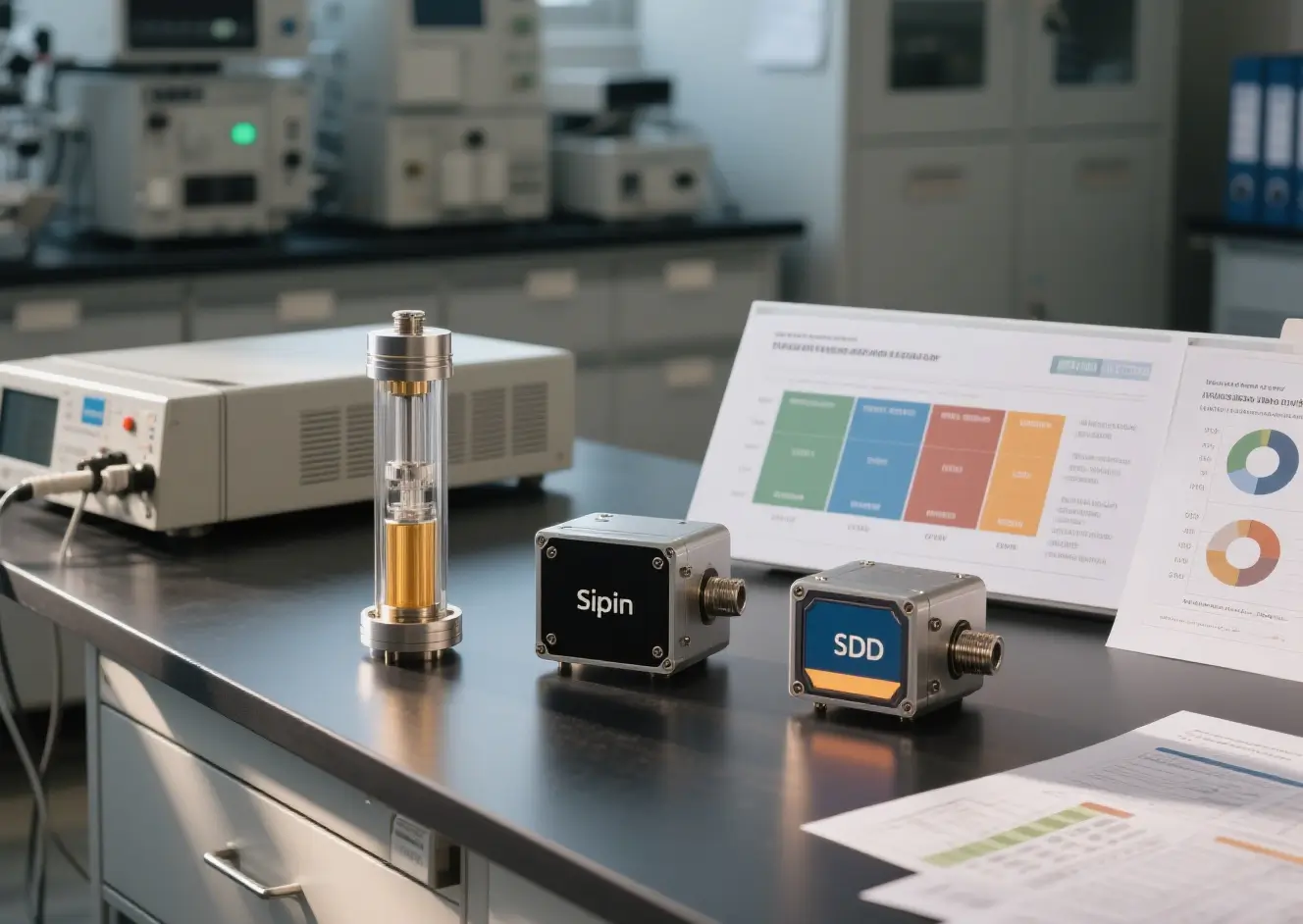
The detector of xrf analyzer serves as the core component that captures x-ray fluorescence signals and transforms them into electrical signals for precise measurement. When the xrf analyzer receives fluorescence from a sample, the detector identifies both the energy and intensity of each signal. This process allows the analyzer to determine which elements are present and in what amounts. Reliable detectors give xrf analysis its benefits, such as high accuracy and reproducibility. Statistical studies show that results from palmare xrf analyzers align closely with those from advanced laboratory methods, supporting the importance of xrf detectors in achieving trustworthy analysis. The use of custom calibrations and certified reference materials further improves precision, making the detector of xrf analyzer essential for accurate results in many applications.
Takeaway chiave
The detector in an XRF analyzer captures x-ray fluorescence and converts it into electrical signals to identify and measure elements in a sample.
XRF detectors provide fast, non-destructive analysis with high accuracy, making them valuable for industries like metal manufacturing, estrazione dati, and recycling.
Different detector types, such as proportional counters, Si-PIN, e Rilevatore di deriva del silicioS (SDD), offer unique benefits; choosing the right one improves analysis speed and sensitivity.
Advanced detectors like SDDs deliver high spectral resolution and low noise, enabling detection of trace elements and complex samples quickly and reliably.
Selecting the proper detector based on the application and testing with real samples ensures accurate, efficiente, and trustworthy elemental analysis.
Detector of XRF Analyzer

Detector Role
The detector of Analizzatore XRF acts as the heart of the xrf system. This detector captures the unique signals produced when a sample emits x-ray fluorescence. Each element in the sample gives off a specific energy signature. The detector measures both the energy and intensity of these signals. This process allows the analyzer to identify which elements are present and how much of each exists in the sample.
The xrf detector provides several benefits. It enables non-destructive analysis, so the sample remains unchanged. The detector also delivers rapid results, often within seconds or minutes. Many industries rely on the xrf analyzer for real-time decisions. For example, metal manufacturing, estrazione dati, and recycling companies use these analyzers to check elemental composition on-site. The detector’s ability to provide accurate and fast elemental analysis supports its importance in these fields.
The importance of xrf detectors lies in their ability to convert x-ray signals into electrical data. This conversion allows the analyzer to display clear, reliable results for users. Scientific studies confirm that the detector can measure trace elements with high precision and repeatability. These benefits make the detector of xrf analyzer essential for accurate and efficient analysis.
Working Principle
The working principle of the xrf detector begins when the xrf analyzer directs high-energy x-rays at a sample. The sample absorbs this energy and emits x-ray fluorescence. The detector captures these fluorescent x-rays. Solid-state detectors, such as silicon drift detectors, use sensitive surfaces to absorb the incoming x-rays. When the detector absorbs an x-ray, it creates a small electrical pulse. The size of this pulse matches the energy of the incoming x-ray.
The xrf system uses advanced electronics to process these pulses. It sorts them by energy and counts how many pulses occur at each energy level. This process creates a spectrum. Each peak in the spectrum matches a specific element. The analyzer uses this information to determine the elemental composition of the sample.
The detector measures both energy and intensity. Energy tells the analyzer which elements are present. Intensity tells how much of each element exists.
The xrf detector can analyze solids, liquids, and powders. It works quickly and does not damage the sample.
Modern detectors, such as silicon drift detectors, offer high sensitivity and low noise. These features improve accuracy and allow detection of elements at very low levels.
Scientific research shows that improvements in detector design, ad esempio larger sensitive areas and better cooling, lead to lower detection limits and higher sensitivity. Technical advances, like microcalorimeter detectors, now allow the analyzer to separate closely spaced energy peaks. This ability helps the xrf analyzer detect subtle differences in chemical states.
The process of converting x-ray fluorescence into electrical signals involves several steps:
The sample emits x-ray fluorescence after excitation.
The detector absorbs these x-rays and generates electrical pulses.
The analyzer processes these pulses to create a digital spectrum.
The system matches peaks in the spectrum to known elements.
This process allows the xrf analyzer to provide accurate, fast, and non-destructive elemental analysis. The detector’s role in this process is critical. Without a reliable detector, the analyzer cannot deliver trustworthy results.
In summary, the detector of Analizzatore XRF enables the system to identify and measure elements in a sample. Its ability to convert x-ray fluorescence into electrical signals forms the foundation of energy dispersive x-ray fluorescence analysis. The detector’s performance directly affects the accuracy, velocità, and reliability of the analyzer.
Types of XRF Detector

Modern xrf analyzers use several types of xrf detector. Each xrf detector type offers unique benefits for analyzing metals, leghe, e altri materiali. The main types of xrf detector include the proportional counter, Si-PIN detector, and silicon drift detector (SDD). Understanding these xrf detector types helps users select the best option for their needs.
Proportional Counter
The proportional counter is one of the oldest xrf detector types. This detector uses a gas-filled chamber to capture x-ray photons. When x-rays enter the chamber, they ionize the gas and create an electrical signal. Proportional counters have a large detector window, which allows high photon flux. They work well for basic xrf analysis of metals and simple alloys.
Proportional counters remain popular for high-volume, routine applications. They offer a cost-effective solution for basic composition checks.
Tuttavia, this xrf detector type has some limits. Proportional counters show higher baseline noise and lower spectral resolution. They often need frequent calibration and can be sensitive to temperature changes. Despite these drawbacks, research shows that proportional counters can still identify samples with similar composition using pattern-recognition methods, even with lower resolution.
Si-PIN Detector
The Si-PIN detector uses a silicon diode to detect x-ray photons. This xrf detector type provides better spectral resolution than proportional counters. Si-PIN detectors use Peltier cooling, which keeps them stable during operation. They deliver low noise and excellent detection limits, making them suitable for measuring thin coatings and complex samples.
A Si-PIN xrf detector can achieve high photon-detection efficiency and respond to small changes in x-ray energy. Scientific studies report that Si-PIN detectors can reach submicron sensitivity and maintain low leakage current, even at high voltages. These features make Si-PIN detectors a strong choice for precise xrf analysis of metals and alloys.
Silicon Drift Detector (SDD)
The silicon drift detector (SDD) represents the most advanced xrf detector type. SDDs use a special silicon structure to collect charge quickly and efficiently. This xrf detector offers the highest count rates and best spectral resolution among all types of xrf detector. SDDs also provide the lowest baseline noise and best detection limits, which is important for trace element analysis in metals and alloys.
Performance Aspect | Proportional Counter (PC) | Silicon Drift Detector (SDD) |
|---|---|---|
Slower; needs multiple scans | Faster; detects many elements at once | |
Element Detection | Needs filters for some elements | Detects multiple elements without filters |
Stability | Sensitive to temperature | Highly stable |
Spectral Resolution | Lower; hard to separate close peaks | Higher; separates complex peaks |
Limiti di rilevamento | Less sensitive to trace elements | Detects trace elements at ppm level |
Application Suitability | Good for basic, high-volume tasks | Best for complex, precise analysis |
Recent advances in SDD design allow for rapid analysis, even in handheld xrf devices. SDDs can handle high count rates and maintain high signal-to-noise ratios. These improvements make SDDs the preferred xrf detector for advanced applications, such as electronics manufacturing and forensic analysis.
Nota: Some older xrf analyzers use Si(Li) or Ge(Li) detectors. These types offer good resolution but require liquid nitrogen cooling and more maintenance. Today, SDDs have replaced them in most modern xrf systems.
X-ray Fluorescence Detection
Energy Measurement
The xrf detector plays a key role in measuring the energy and intensity of x-ray fluorescence. When the xrf system excites a sample, the sample emits fluorescent x-rays. Each element in the sample produces x-rays with unique energies. The detector captures these x-rays and measures their energy. This process helps the Analizzatore XRF identify which elements are present and how much of each exists.
Researchers have studied how different detector materials, such as CdTe, CZT, and Si, respond to x-ray fluorescence.
CdTe and CZT detectors show high efficiency for detecting fluorescent x-rays in the 20-100 keV range.
Si detectors work well at lower energies but have lower efficiency at higher energies.
The geometry of the detector affects the intensity of detected fluorescence, but it does not greatly impact energy resolution.
Scientists use calibration with known fluorescent materials to ensure accurate energy measurement.
Optimizing detector material and geometry helps maximize the signal and reduce background noise.
The xrf detector must measure both the energy and intensity of the incoming x-rays. Energy tells the analyzer which elements are present. Intensity shows how much of each element exists in the sample. This information is vital for accurate elemental composition analysis.
Signal Processing
After the detector captures x-ray fluorescence, it converts the energy into an electrical signal. The process begins when an incoming x-ray photon hits the detector. Le xrf detector uses semiconductor material to create electron-hole pairs. The number of pairs matches the energy of the photon.
The detector sends this charge to a preamplifier, which turns it into a voltage signal. A pulse shaper then amplifies and cleans the signal, making it easier to measure. The shaped signal passes through comparators that check its height against set thresholds. When the signal passes a threshold, the system records a count.
The xrf analyzer uses an analog-to-digital converter to turn the voltage signal into a digital one. A digital pulse processor measures the height of each pulse, which matches the energy of the detected photon. The analyzer collects these digital signals and creates a spectrum. Each peak in the spectrum represents a different element.
This process, known as energy dispersive x-ray fluorescence, allows the xrf system to quickly and accurately identify elements and measure their amounts. The detector’s ability to process signals efficiently ensures reliable analysis for many applications.
XRF Analyzer Performance
Accuracy and Sensitivity
The choice of detector in an xrf analyzer shapes the accuracy and sensitivity of every analysis. Advanced detectors, such as silicon drift detectors, help the analyzer deliver rapid and sensitive results. A recent case study in Nature shows that deep learning models can extract meaningful signals from xrf data. These models achieve strong positive correlations above 0.90 between predicted and actual xrf signals. The analyzer, with the right detector, can process signals quickly and with minimal bias. This performance supports reliable chemical analysis in many applications.
The xrf analyzer benefits from high sensitivity when detecting trace elements in metals and alloys. High spectral resolution allows the analyzer to separate closely spaced peaks. This feature is important for precious metals analysis and recycling. The analyzer also benefits from low noise, which improves the detection of low concentrations. Portatile xrf analyzers use these advanced detectors to provide fast and accurate results in the field. The benefits of rapid analysis and high sensitivity make the xrf analyzer a key tool for recycling and other key applications of xrf analyzers.
Application Suitability
The right detector ensures the analyzer matches the needs of different applications. Users must know how to choose the right xrf detector for each task. Xrf analyzers work well in both laboratory and field settings. They offer non-destructive analysis, portabilità, and cost savings compared to other methods. These benefits make the analyzer suitable for environmental monitoring, geology, recycling, and industrial applications.
When selecting a detector, users should:
Identify the materials, such as metals or alloys, for analysis.
Choose between PIN or SDD detectors based on sensitivity and speed.
Select detector size for throughput and sensitivity.
Consider anode material for the best results with specific elements.
Evaluate features like cameras or collimators for special applications.
Check environmental ratings for field use.
Test the analyzer with real samples.
These steps help users understand how to choose the right xrf detector for their application. The analyzer’s performance depends on matching detector features to the demands of key applications of xrf analyzers, such as recycling, precious metals analysis, and chemical analysis. The benefits of proper detector selection include reliable composition results and efficient elemental analysis across many applications.
Understanding the detector in an xrf analyzer helps users achieve accurate analysis. Detector type shapes the analyzer’s performance and fits different applications. The xrf detector supports fast, reliable results in many applications. Users should:
Match detector type to the xrf analyzer’s purpose.
Test the analyzer with real samples from their applications.
Review detector features for best analysis in all applications.
Choosing the right detector ensures the analyzer meets the needs of every xrf application.
FAQ
What does the detector in an XRF analyzer do?
The detector captures x-ray fluorescence from the sample. It measures the energy and intensity of these x-rays. This information helps the analyzer identify and measure the elements in the sample.
How does a silicon drift detector (SDD) improve XRF analysis?
An SDD provides high sensitivity and fast response. It separates closely spaced energy peaks. This feature allows the analyzer to detect trace elements and deliver accurate results quickly.
Can XRF detectors analyze liquids and powders?
Yes, XRF detectors can analyze solids, liquids, and powders. The detector does not damage the sample. Many industries use XRF analyzers for different sample types.
Why is detector choice important for XRF analyzers?
Detector choice affects accuracy, velocità, and sensitivity. Some detectors work better for trace elements. Others suit routine checks. Users should match the detector to their analysis needs.
Do XRF detectors need regular maintenance?
Most modern detectors need little maintenance. Older types, like Si(Li) detectors, may require cooling and more care. Users should follow the manufacturer’s guidelines for best performance.







Contatti
Scansiona il codice QR per avviare una chat WhatsApp con noi.